Ijraset Journal For Research in Applied Science and Engineering Technology
- Home / Ijraset
- On This Page
- Abstract
- Introduction
- Conclusion
- References
- Copyright
Workplace Injuries: A Comparative Study of Young and Old Workers in a Construction Site
Authors: Ahmad Aseer
DOI Link: https://doi.org/10.22214/ijraset.2024.58309
Certificate: View Certificate
Abstract
It has been shown by the research that young workers (<25 years old) are more subjected to workplace injuries than old workers. But paradoxically, the injuries that young workers are exposed to are not severe. The study is aimed to find out risk factors for injuries in construction industry focusing on the risk factors associated with young workers. The results show that young workers are more involved in workplace injuries than old workers, irrespective of considering department size and type of discipline. However, when variables are added for physical and psychosocial work environment in the safety climate model, age seems to be of less importance. Physical demands (vibration and heavy lifting) and control over work pace are concerned with an increased risk for injuries. This may indicate that the work task distribution among different age groups has an impact on injury risk. Safety climate is not associated with risk for injuries. The study has an indication that the work task distribution between two groups ought to be further explained in relation with injury risk.
Introduction
I. INTRODUCTION
The aim of this study is to find out the difference in injury between old and young workers working in the selected organization, and further to study attitude and behaviour of the workers towards health and safety for a certain duration of time. This research work tests the hypothesis that workplace injury rate is higher in young age group of workers than in the old workers. An assumption is also that safety climate is of importance for injury involvement, in the sense that positive safety climate assessments are negatively related to injury involvement and vice versa. Safety climate has, therefore, also being included in the model for this study.
The research questions are:
- Is age an independent risk factor for injuries within the selected construction industry?
- Is there any association between age and injuries, and how is it affected by physical and psychosocial work environment and safety climate assessments?
- The objectives set for this research to achieve the aims are:
- to collect and analyze data of workplace injuries in the selected organization
- to analyze the accident and injury rates in both young and old workers in a specified duration of time
- to find out workers’ behaviour and attitude towards health and safety, and to see its impact on workplace injuries and incidents
- to analyze the root cause of workplace injury and recommend the corrective and preventive actions to avoid such incidents in all business operations of the selected company.
According to an estimation made by the International Labour Organization (ILO), a much increased number of young workers (15-24 years old) and old workers (60 years and above) are expected to enter the workforce in the next 15 years (WHO, 2005). WHO (2005) states that these two age groups of workers show a much higher disposition to accident rates. Although the work related accidents and injuries have been reduced to a larger extent recently, the construction industry remains as one of the vulnerable workplace owing to accidents happening at the sites, especially in the Gulf region (QCS, 2014). As the Gulf regions are developing fast, there is an immense rise in the construction works due to the expected developments in a short span of time. In spite of the potential health and safety management, that ensures safety to workers and the environment, frequency rate of injury is higher at the construction workplaces (QCS, 2014). When the root cause of the accidents and injury in relation to human error, behavioural models and other human factors is analyzed, it is found that human behaviour has been the main reason of accidents at workplaces (Heinrich et al., 1980).
The sensitivity of this issue is highlighted because workers’ attitude and behaviour has a great impact on their health and safety, and on their surroundings; both positively and negatively. As far as young workers are concerned, they have poor judgmental capacity to face critical issues because of their inexperience, workplace peer pressure and willingness of risk taking (Siskind, 1982).
In this context, it is necessary to analyze their attitudes to try to find out whether young workers’ attitudes and behaviour make any difference and how the attitudes of old workers vary from those of young workers. Godwin et al. (2007) states that motivation, attention and perception also change according to the type of worker (young or old), experience of worker (new or experienced) and fatigue. Old workers are different from young workers in terms of physical and mental status. The deterioration of physical condition reduces working capacities and recovery rates. The declining energy and physical health may affect their safety climate and give rise to a dangerous working environment (see Fig. 1).
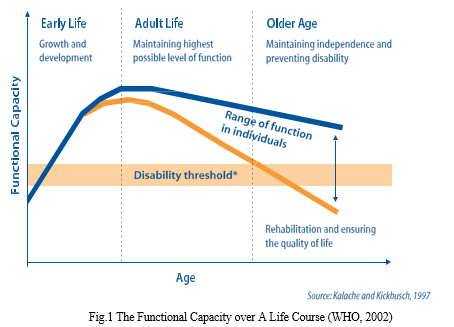
The relationship between injury rate and safety culture or climate is interconnected. However, they are complicated and unclear mainly as a result of the measurement issues. Different studies encompass different levels of analysis (Clarke, 2000):
a. comparing two groups of employees (young and old workers) within one company– with a high level of injury rate and with a low level of injury rate and comparing individual climate scores;
b. aggregating climate scores across groups and departments and comparing with injury rates;
c. some studies refer injuries and accidents in terms of lower or higher severity.
Thompson et al. (1998) has given three reasons for which the accident rate is not a good measure of a company’s safety. They gave reasons that accidents are rare events, not always under the control of job incumbents and it is not always consistently recorded. Cooper (2000) adds that these types of data ignore the different exposures to risk inherent in occupations and that this can result in under-reporting or over-reporting of accidents. Taking these disadvantages into consideration, Zohar (2000) introduced a new outcome criterion called “micro-accidents”. In his research, micro-accidents correlated significantly with lost-days accidents and are significantly predicted by the safety climate scale (Zohar, 2000).
The study can further be elaborating, after observing the selected organization, the high injury group and what the root cause possibly is for their increased risk rate of injury. The issue has been highlighted, so that the management can arrange additional training programmes to facilitate an opportunity to vulnerable group with a view to make the health and safety management free from workplace incidents and injuries. This will also ensure the health, safety and wellbeing of young workers through improved risk assessment, safe workplace design, suitable engineering controls, provision and use of proper personal protective equipment and safety trainings.
II. LITERATURE REVIEW
In this chapter an attempt has been made to review the relevant writings on workplace injuries of young and old workers in various industries. The chapter critically reviews conditions and circumstances, under which young and old workers have to bear workplace injuries.
Workers and injuries have been considered particularly in the context of their gender, age, experience, training and behavioural safety. The most important aspect the chapter reviews is the impact of the practices of the organizational health and safety on young and old workers, who are often compared in contrast.
A. Review
The crucial issue whether young workers are more prone to workplace injuries or the older workers, has been emphatically thought of for some decades, and it has been explored that while at work young workers who have less experience are more likely to suffer injuries and fatalities than old workers who are more experienced (Breslin et al., 2003). It was further stated by Breslin et al. (2003) that there has been frequent injury to adolescents who work in the USA, Canada and Europe and this high frequency of injury is considered to be a public health hazard, a matter of great concern. It has also been found out that the likelihood of being trapped in workplace accidents varies by gender, age and the industry type (Breslin et al., 2003). Owing to the vulnerability of age and gender, it has been observed that compensation claims for male adolescent and young adults were higher than those from older male age groups, and this was consistent with the previous researches. However, as far as female workers of the same age group are concerned, the pattern was antithetical; the claims for compensation were much lower (Breslin et al., 2003). The experience and cognitive abilities of young workers are often considered to be less developed and are described as a perception of invulnerability (Barker et al., 1996; Hargreaves and Davies 1996). The fact is supported by a Canadian study, arguing that the risk of accidents among young adult workers is higher because of the nature of work and the poor conditions of work environment (Breslin et al., 2007a, b).
At this point, it is important to know the reasons why young workers have a higher occupational accident rate. Salminen’s study (Salminen, 2004) has provided three reasons that are as follows:
- As most studies elaborate, the rate of accident and fatality is based on the number of workers working full-time. However, most of the young workers work part-time;
- Young workers have less experience than old workers;
- In spite of the prohibition by the law, young workers do dangerous jobs (Council Directive, 1994).
Various data clearly justify young workers’ accident rate. According to the European Statistics on Accidents at Work (ESAW), the incident rate of work related non-fatal accidents per 100,000 workers in Europe was more than 40% higher among those aged 18-24 years in 2002, in comparison with the total workforce (EU-OSHA, 2015). Correspondingly, in 2003 young workers between 18 to 24 years of age accounted for 4.7 % of non-fatal occupational accidents compared to 3.3 % of workers overall. There was a decrease in the accidents between 1995 and 2003, but this decrease in the proportion of young workers involved in accidents was much smaller than that of the older workers. So, the fact remains that while at work young workers are at a greater risk of having an occupational accident, though the average severity rate is lower (EU-OSHA, 2015). Age factor has been one of the main reasons for occupational accidents. Adolescent males have been found to be suffering 1.5 to 4 times more accidents than the workers over 25 years (Breslin et al., 2003).
It is further to be noted that the age at which a certain injury occurs and the length of service are strongly correlated. Some earlier researches showed that it was in the first year of their employment when 40% of workers below 35 years of age suffered injuries (Root and Hoefer, 1979). Other researches have also found out that in 60% of the accident cases from manual handling in construction industry, the incidents were observed to be in the first year of the workers’ employment (Stubbs and Nicholson, 1979).
One of the most striking studies that describes changes in the age related occupational injuries has been the analysis of the compensation data from 30 states in the United States, which elucidates that the reasons of lower accident rates among older workers are their experience, maturity, and awareness of hazards (Root, 1981). Contrarily, the higher rates of accidents among older workers are because of the fact that they become either careless or have declining reflexes. On the other hand, younger workers have higher accident rates because of their recklessness, dangerous jobs and greenness to hazards. And if they have lower accident rates, this means they have superior reflexes or they are exposed very less to the dangerous jobs that require experience (Root, 1981). This is the reason why young workers need training, information and supervision (EU-OSHA, 2015).
It is worth noting that accident rates vary and they are sometimes unexpected, irrespective of workers’ maturity or experience. For example, a study during 1924 and 1925 in a coal mine industry ( it is important in this context to cite such a classical accident study) showed that working in 10 coal mines the highest risk was faced by workers over the age of 59 years, followed by the workers under 20 (Vernon and Bedford, 1928). In this study, the workers at the safest position were 30-39 years old.
On the contrary, in his study Van Zelst (1954) made it clear that older workers had lower accident rates than young workers having the same job experience at a copper plant. The report of Root (1981) suggests that injuries generally occur to workers of all ages in similar proportions. However, inexperience, decreasing coordination, occupational restraints and senility are the notable differences reflecting varied accidents (Root, 1981). Some other factors, such as heaviness of work, monotony or psychologically demanding work might disrupt young workers, as it was found in a Danish study (Rasmussen et al., 2011). These factors along with the factor of low social support increase the risk of accidents (Wegman and McGee, 2004).
There have been conflicting findings as well concerning age and risks of accidents. In a result of frequency and severity of accident rates in relation to age factor, it was found that age was either preventing, or aggregating or was having no effect on frequency and severity of accidents (Laflamme and Menckel, 1995). It was further observed that these conflicting findings were because of the risks being distributed unequally on age groups. Schmidt et al. (1984) and Mitchell (1988) also pointed out that both task and age had important distinctive effects on accident rates. In this context, some of the researches followed Warr’s framework (Warr, 1994). According to this framework, occupational activities are classified into four categories viz. age-impaired, age-counteracted, age-neutral and age-enhanced. This classification is based upon the change of job performance by the influences of accumulated experience and decreasing basic capacities (Warr, 1994). A new dimension of age factor was presented by Laflamme and Menckel (1995) who assumed that age is a negative factor in occupational performance and in the occurrence of accidents, because only a few kinds of activities, such as strenuous physical activity, had been grouped as age-impaired (Warr, 1994). Furthermore, some researchers believed that age and occupational accidents are related to what is called as positive linear or U-shaped (Chi and Wu, 1997). In this positive linear relationship, the rise of the occurrence of accidents is caused by the decline in age (Laflamme and Menckel, 1995). Laflamme and Menckel (1995) gave the examples of accident occurrences as slipping, tripping and fall from a height with fatal injuries.
In health care sectors, age and back injuries of nurses was studied and it was reported that in the studies of the effect of age, contradictory results were found. Although age plays an important role in determining workers’ capacity to overcome the back injury (Chaffin and Ashton-Miller, 1991), some researchers have found no relationship between age and back injuries. Some research has found that young nurses have frequently experienced back pain (Mandel and Lohman, 1987) and accidents (Engkvist et al., 1992), although the length absences from work has increased with age. Some other studies have not found any relation between age and back problems (King, 1955; Rhodes, 1983; Root, 1981). However, the rates of back problems were found to be increased among nurses over 40 years of age in a French hospital (Davezies, 1992).
B. Occupational diseases
There has been an increasing difficulty old workers face while performing certain tasks, such as firefighters (Cloutier and Champoux 2000). In this case organizational flexibility should be taken into account, while observing the relationship between age and accidents. Of the health problems, young workers had a lower chance of musculoskeletal problems, stress, depression or anxiety, but they had a slightly higher chance of pulmonary disorders (Karjalainen, 2006). The total incidence of diseases increases with age. It has been found that old workers have experienced a longer exposure to risk factors at work, so they have a greater possibility of having occupational diseases, because of their long working career. On the contrary, young workers have a lower chance of developing occupational diseases. It is therefore, important to note that the chances of getting work-related diseases have nothing to do with age (Karjalainen, 2006). Nevertheless, the cases of acute diseases, like allergic and toxic reactions could be higher among young workers, if not the chronic diseases, because of the fact that typical selection and the ‘healthy worker effect’ have little time to take effect (Rantanen, 2003). These occupational diseases are unnoticed or never reported. Under reporting of accidents and occupational diseases is a major problem among young workers, which occurs due to young workers’ lack of knowledge of the reporting process and hesitation to report hazards and risks (Breslin et al., 2005).
C. Legislation governing young workers
Young workers are vulnerable and in the light of their susceptibility, the European Council has issued the Directive 94/33/CE so as to direct companies to take care of the young workers (Council Directive, 1994).
The Fair Labour Standards Act (FLSA), 1938 protects young people from working in hazardous conditions and it emphasizes on a very important reminding that work should not interfere with their education (FLSA, 2011) in USA. The aforesaid regulations have emphatically limited the extent and type of work young people under 18 years can take up.
The Protection of Young Persons (Employment) Act (Irish Statute Book, 1996) aims to protect young workers’ health and asks companies for an assurance that their work during school years does not affect their education. The Act fixes minimum age limits and sets intervals for rest. It also prohibits late night work for those who are under 18 years.
As far as the enforcement of regulations regarding young people in Qatar is concerned, as per Qatar Labour Law 14, Article 86 (QCS, 2014), a young person who is under 16 years cannot be employed in a Qatar workplace. The law directs the companies to make sure that young peoples’ health and safety is not at risk. If the workplace has one or more young persons, the employer must make sure that the risk assessment is suitable and sufficient, and the due account is maintained for their immaturity and their ignorance of the potential risks (QCS 2014).
D. Conclusion of Literature Review
Comparing young and old workers in terms of risks and work related injuries, the following conclusions out of this literature review can be drawn:
- Young workers do the jobs having little or no training (NIOSH, 2003; Bowling et al., 1998; Runyan and Zakocs, 2000),
- Young workers frequently change jobs, so they lack consistency (Runyan and Zakocs, 2000),
- Old workers develop skills and are confined to one job area, whereas young workers do a wide variety of works, such as working in a restaurant, taking orders, serving food, cleaning and mowing the grass (Runyan and Zakocs, 2000),
- Young workers do their jobs with little or without supervision (Runyan and Zakocs, 2000),
- Young workers lack the experience and their physical and emotional maturity is needed to do a job (NIOSH, 2003),
- Their unfamiliarity with the requirements of work procedures for some tasks (NIOSH, 2003),
- Young workers are not aware of their legal rights and are ignorant of the prohibitions (NIOSH, 2003; Castillo et al., 1999),
- They are more likely to suffer exposure to hazardous substances than old workers (NIOSH, 2003).
The review discussed about the differences between young and old workers on the basis of their physical, psychological, and social responses, and is finally obtained that aging process makes functional capacity lower (Wegman and McGee, 2004). However, aging process also increases experience that tends to enhance skill and expertise.
The final point that should be highlighted is that little pragmatic research about workplace accidents among young workers has been published in the State of Qatar.
III. METHODOLOGY
In this chapter the research methodology is outlined and the relevant information or data has been obtained from the use of research methodology and strategy. Methodology, as Oliver (2004) asserts, deals with the practical steps for how much organized the whole research project is. The research methodology proposes an elucidation of the nature and process of the research, so that problem should be sorted out and relevant solutions to a particular problem can be obtained (Welman et al., 2006).
The literature review underpins the research problem for a clear understanding of the background of the problem, which is then investigated. According to Kothari (2004), a researcher is required by a research problem to find out the best solution to a given problem. The problem investigated is the potential benefit to not only the young and old construction workers’ health and safety, but also to the company at large.
Despite several control procedures and safe system of works in construction industry, both young and older construction workers are exposed to many hazards and ergonomic challenges, and there is a perceived demand from clients, contractors and supplier to consider safe condition and injury free work environment for construction workers (QCS, 2014).
As far as a hypothesis of a research is concerned, it is a declaration or proposition that is to be tested, relating to the empirical study findings (Welman et al., 2006). Fellows and Liu (2008) further asserted that it is significant to use hypotheses in research when the study is based on theory and previous work. The research problem and hypotheses guide the gathering of information required to lead the formulation of research objectives. When these are connected together, they form a strategic plan of how to address the research problem.
A. Research design
The design of the research involves the primary step of the selection of methods, where a data is collected and analyzed with the purpose of fulfilling the research aims.
When the researcher determines a certain problem to be investigated, the research design is considered. The researcher has clear objectives and measurable hypothesis (Marczyk et al., 2005). The following five factors determine the effectiveness of the research design:
- the process to obtain information,
- the presence and skills of the researcher,
- the objectives of study problem,
- the nature of the study problem, and
- the availability of time and money for the research work (Kothari, 2004).
Different levels of analysis can result in different results. Different companies have different standards and different countries have different legal standards for reporting injuries and accidents. The accident rate is not a good measure of the safety of a company (Thompson et al., 1998) because of the fact that:
a. accidents are usually rare events, so the frequency of accidents can be statistically unreliable due to the restriction of variance;
b. accidents are not always under the control of employees;
c. accidents are not always consistently recorded. Probst and Brubaker (2001) demonstrated that for every reported accident there are on an average 2.48 unreported accidents.
These types of data ignore the actual exposures of risk inherent in occupations and that this can result in under-reporting or over-reporting (Cooper, 2000).
Taking these disadvantages into consideration, on-the-job behavioural factors are considered in the analysis of accidents of young and old workers, even minor in nature.
Many studies investigating the impact of safety climate on accident use different measures made up of different dimensions, and this limits the generalizability of the findings. Nielsen et al., (2008) used a Danish safety culture questionnaire composed of leadership, organizational and worker factors.
Furthermore, models that seek an establishment of relationship between injury/accident rate and safety climate provide inconsistent results suggesting variously, for example, that accident rate is directly predicted by safety climate (Wallace et al., 2006) or that relationship is mediated by safety behaviour and hazards.
Despite these limitations, all of the studies cited above have reported a positive effect (direct or indirect) of safety climate on the injury/accident rate. Therefore, it has been considered in this study to have behavioural safety inputs while comparing safety culture or climate and injuries among young and old workers.
B. Overview of Research Strategy
When a data is collected by means of strategies and methods, it is to make sure that methods are precise and clear, as the outcomes of the research could be impacted on (Fellows and Liu, 2008). Kothari (2004) has elaborated more on the type of methods required by saying that a researcher needs to know how indices or tests should be developed, how the mean, mode, median, standard deviation or chi-square could be calculated, and how a particular research techniques should be applied. Not only these, a researcher also needs to know the relevance of the methods and techniques, and true meaning of them (Kothari, 2004).
Quantitative method and qualitative method are the two kinds of methods applied in a research project to collect data. These two methods differ from each other in many ways, but simultaneously, they seem to complement each other at same point (Neuman, 2000).
The primary difference between the two approaches is that for quantitative method the objective data consisting of the numerical presentation of the findings is required, while in qualitative method subjective data, with respondents expressing their own opinions, is required. Both quantitative and qualitative approaches have been adopted for this study. The figure below (see Fig. 2) shows the research strategy which was utilized for this research study.

C. Quantitative Approach
In quantitative approach, researchers make use of statistical analysis, where researcher’s data is converted to a numerical index, so that findings derived from a sample could be generalized so as to make the data accessible to the population. In this approach, informal understanding coming from the researcher’s experience, plays a vital role (Neuman, 2000). Quantitative study aims to direct all components in actions and depictions of the respondents (Henning et al., 2004). It is typical of the quantitative research that it is composed of experimental and survey research. Survey research, that involves a sample of population, is very useful in determining its characteristics (Kothari, 2004). Interviews or questionnaires are used to sample research respondents so as to obtain the most possible required data. On the other hand, the experimental research involves a comparison of two groups at a single outcome measure, so that some hypothesis of the causation may be tested (Marczyk et al., 2005).
In the context of this study, the literature review has suggested that comparison of young and old workers’ safety behaviour and analysis of accident records would lead to potential improvements of health and safety culture within the organization. The statistical survey approach has been useful for this study to determine counts, weight or mass of respondents relative to the health and safety problems and the injury rates. However, the adoption of a quantitative method alone would not cover all the necessary data required. The qualitative research approach has also been utilized to get the real result of the impact of other health and safety dimensions connected to young and old workers.
D. Qualitative approach
Qualitative research studies do not measure and quantify their results in the same way as the quantitative approach does (Marczyk et al., 2005). However, qualitative research uses unchanged logic to get what is real in terms of quality, meanings, contexts, or images of reality based on what people actually do. The aim of qualitative research is to obtain answers from questions based on ‘what’, ‘how’ or ‘why’ instead of trying to find out ‘how many’ or ‘how much’ (Green and Thorogood, 2004). The advantage of qualitative research is that it recognizes the different experiences of respondents who are free to give their insights in a relatively unrestricted manner, especially in this study where under-reporting of injuries is one of the major challenges expected. Further, qualitative methods can be difficult to analyze, since respondents may provide so many different opinions that may affect the reliability and validity of the study.
E. Data collection method
Primary and secondary are the two sets of data that are collected by the researchers for the research (Kumar, 1999). In primary data, a data is collected with practical methods, whereas at secondary level relevant literature is reviewed, which is derived from the theoretical knowledge. The process of the secondary set involves reading, understanding, linking ideas and the construction of theoretical information with the purpose of identifying a research problem. It also includes the use of existing databases and other data that have been collected by other researchers and are in the public domain.
The literature review supplies a clear awareness of the type of questionnaire suiting the study, participants involved and the type of research instrument to be adopted. The literature review has been drawn from various journals, publications, textbooks, conference proceedings and internet sources of information. Despite the relevance of the information gathered from different literature studies and presentation, Welman and Kruger (2003) argued that these studies should be linked together, so as to provide the flow of a logical argument.
The primary data has been gathered from the limited number of construction sites, offices of designers, subcontractors and workers. In collecting primary data, as Kumar (1999) has indicated, various methods are adopted depending on the nature of the population targeted. There are three data sources, viz. compensation claims of workers, health records, and questionnaire surveys. Each source has its advantages and limitations. On its limitation, there could be under-reporting of workers’ injuries, which might be a limitation with their compensation claims. For example, those workers who had suffered injuries deserved a compensation, but they never thought of filing for a claim for compensation. This was mainly found among those workers who sensed that their injury was not that serious (Shannon and Lowe, 2002).
F. Study population
The population is the study entity which comprises individuals, groups, organizations, events and human products (Welman and Kruger, 2003). The population is a successive pool out of which a researcher draws the process of selecting sample elements and where the generalization of findings is done. The findings can only be generalized if the process of selecting elements is representative. ‘Representative’ means that the selection process (sample) has the properties that are exactly in the same proportions to the population, but smaller in number (Welman et al., 2006). According to Kothari (2004), the selected respondents should represent the total population for the study, as far as possible, making the process (sample) small. In addition to this, the research problem ought to be related with a particular population before the process of analyzing the population is drawn for the study (Welman et al., 2006). Furthermore, the study population, as far as this study is concerned, has included all the workers within the building and construction sites of the company. Excluded were those below 18 years of age, not being able to read or understand either English, Hindi or Arabic, and workers having a solely administrative position in the organization (i.e. not at all present at the work site). Apprentices and other employees being temporarily engaged have been included. The study focus has been on the young and old workers, since it is of interest to explore if age constitutes an explanatory factor or not in work related accidents or ill health.
G. Questionnaire Design
De Vos et al., (2002) has well defined a questionnaire as an arrangement of questions on a format which the respondent completes for a research project. Respondents are issued a questionnaire that is read, interpreted and answered. The purpose of a questionnaire is to seek the views of individuals, groups or organizations who respond against a particular issue. There are two different forms of questions in a questionnaire – open ended and closed ended questions (Fellows and Liu, 2008).
Both types of questions have been adopted in this study. The study is designed as a cross-sectional questionnaire survey among building and construction workers older than 18 years.
Closed ended questions are also acknowledged as quantitative questions, the data of which is analyzed statistically and where a wide range of statements is given to the respondents who are supposed to tick the appropriate box (Welman et al., 2006). There is a restriction for the respondents while they answer the questions, as there is a specific way of answering the questions.
On the other hand, in open ended questions respondents are accounted on their direct thoughts and insight (Welman et al., 2006). In these types of questions, the researcher’s inputs don’t influence the respondents’ answers; hence, the respondents speak or write what they really feel. Although these questions are easy to ask, they may pose difficulties for respondents to answer given that they require critical thoughts. Fellows and Liu (2008) has further indicated that very often the researcher faces difficulties in analyzing the responses of the respondents to the questions asked. Another difficulty, as Kothari (2004) has argued, is that the questionnaire method works slowly, as many of the respondents are careless in returning it on time despite several reminders.
The questionnaire survey was conducted in the period March 2015-August 2015. Contact with building and construction projects was established, asking for permission to perform a survey at the work site. After an appointment was made, a site visit was scheduled during a lunch break. The questionnaires were mostly filled out during this break at the work site. Face-to-face interviews were conducted on construction sites with workers to complement the data from questionnaires. Meetings with the respondents were set up via telephone prior to the visit. During these meetings, respondents were given questionnaires to complete in the presence of the researcher. However, some respondents indicated that they were busy and would return the questionnaire via email or the researcher should return and pick them up on a particular day. Occasionally, larger groups from the company filled out the questionnaire during an assembling (e.g. safety meeting and toolbox talk meetings).
H. Reliability, validity and risk factors
The instrument of collecting data should be reliable, and for being reliable it has to be consistent, dependable and stable. Most importantly, if there is consistency in the research results, this means the research instrument is reliable. The sound and reliable research instrument will give valid conclusions. Fellows and Liu (2008) states that the internal reliability of statements is measured by Cronbach’s alpha, which ranges from 0 to 0.1. In this study, Cronbach's alpha coefficient of reliability has been determined for scaled questions. The analysis of the reliability of scaled responses has been done by using Statistical Package for the Social Science (SPSS). Validity is concerned with accuracy, effectiveness or trustworthiness of the interpreted data. According to Kothari (2004), validity is the degree to which differences observe with a measuring instrument, which reflects true differences among those being tested. It is, therefore, important for the researcher to be concise and clear as far as possible while designing research instruments.
The validity of hypothesis has been tested through t-test. When the data is collected and interpreted, the hypothesis is tested to check its validity or truthfulness. Conversely, Fellows and Liu (2008) argued that not all research projects would require testing of hypotheses which may either be rejected or not be rejected depending on the findings of the study.
Psychosocial work environment has been assessed by single items from QPSNORDIC (Lindström et al., 2000). The launch of the programme geared by Nordic Council of Ministers was aimed to improve the data in terms of its quality and comparability. This was to improve the data that was collected during interventions on the work environment conditioned by the psychological, social, and organizational bases. A general Nordic Questionnaire (QPSNORDIC) is used for embodying the basic workplace psychological and social factors. This has also been the aim of this study to apply workplace interventions and safety climate in the research. The QPSNORDIC is a set of multiple choice questions that are related with the workplace psychological and social factors, such as quantitative demands, control over work pace, influence on overtime, and help and support from colleagues and superiors (Lindström et al., 2000). In this study the perceptions of safety climate have been assessed by the use of Nordic Occupational Safety Climate Questionnaire (see Appendix-1). The questionnaire consists of 50 positively formulated and negated (reversed) items using a four-point Likert scale (Kines et al., 2011). The 50 items which form the seven dimensions are evaluated on a four-point scale from “strongly disagree” to “strongly agree”. The physical work demands are assessed by items from the questionnaire on a five point risk level scale from “very seldom” to “very often”. These items have measured vibration, physical demands related to heavy lifting, repetitive and monotonous movements, work with arms above shoulders and work with bent/twisted back or neck.
Safety climate is the term that is preferably used to suggest the application of psychometric questionnaire studies in the form of measurement instrument (Hale and Hovden, 1998). On its negative side, when the qualities of the inclusion of personality variables in safety climate scales are done, it becomes controversial, as it is known to be a failure to predict the involvement of accidents (Lawton and Parker, 1998).
However, safety climate has been effectively used in this study. The seven dimensions used in the questionnaire consist of:
- Management safety priority, commitment and competence,
- Management safety empowerment,
- Management safety justice,
- Workers’ safety commitment,
- Workers’ safety priority and risk non-acceptance,
- Safety communication, learning and trust in co-workers’ safety competence, and
- Workers’ trust in the efficacy of safety systems.
Dimension structure and internal consistency (Cronbach’s alpha) for the seven dimensions have been analyzed in context of work injuries among young and old workers and its relation to above seven dimensions (see Appendix-2).
I. Outcome Variable
For this study the outcome variable is injury involvement. In the questionnaire, the respondents were asked if and how many times the last six months they had been hurt in a specific accident, where they had to stop working for one hour or more. Each of the alternatives was formed as an individual question, with categories “yes” and “no” pertaining to pinch, hit, collision, electrical shock, fall on same level, fall from height, object in the eye, cut or scratch, violent threat, overstrain, or being buried. A sum score was made and the respondents were classified as “injured” and “not injured”, irrespective of one or several injures.
J. Analysis
A descriptive analysis has been performed for risk factors and outcome; for each item describing physical and psychosocial work environment and for each of the safety climate dimensions. Mean and SD have been calculated using t-tests to find significant differences in risk factors according to age and injury involvement. A stepwise logistic regression is performed, using injury involvement (injured/not injured) as outcome variable. The statistical analysis has been performed in SPSS 18.0.
K. Confidentiality of Information
The survey and interventions must be planned to make sure that there is no discrimination between individuals and that the information regarding the individual is anonymous and is protected. An information in advance has been passed on to the respondents about the purpose of the questionnaire, how it would be administered and analyzed and how the presentation of the results is done. The individual data should be confidentially maintained during and after the research work.
IV. RESULTS
When workers have been given the questionnaire for their responses, a total of 474 workers answered the questionnaire. 17 questionnaires have been removed from the sample due to insufficient understanding of the language. Additionally, one respondent has turned out to be below 18 years old which left a total sample of 456 respondents. 445 of these respondents represent 26 pre-recruited departments, in addition to an uncertain number of subcontractors present on the days of data collection. Due to the uniqueness of this research and interest of workers, the response rate on site has been 98%.
Background variables for the final sample are shown in Table I. Young workers (< 25 years) constitute 30.4 % of the total sample (missing N=39). 38.2 % of all respondents are unskilled or apprentices. Most respondents work within building (the raising of buildings), followed by adjacent building disciplines, labeled “building/construction techniques” (e.g. scaffolding, insulation, flooring, painting, plumbing and ventilation work), and construction (e.g. ground work and infrastructure). To counter obliquity between these groups in the analyses, carpentry is separated from the building/raising category, while electrical trades are separated from building/construction techniques because of its distinctive character.
TABLE I
Demographic variables
|
Variable |
Category |
% |
|
Age |
18-20 years |
17.2 |
|
|
21-24 years |
13.2 |
|
|
25-34 years |
24.1 |
|
|
35-44 years
|
20.9 |
|
|
45-54 years
|
16 |
|
|
≥ 55 years
|
8.6 |
|
Education |
Unskilled |
22.6 |
|
|
Apprentice |
15.6 |
|
|
Skilled |
53.6 |
|
|
University/University college |
8.3 |
|
Type of discipline |
Building/raising (not carpentry)
|
31.4 |
|
|
Carpentry
|
21.3 |
|
|
Electrical trades
|
13.2
|
|
|
Building/construction techniques
|
14.8 |
|
|
Construction (ground work, infrastructure)
|
19.3
|
|
Department size |
1-9 workers |
5.8
|
|
|
10-19 workers |
10.4
|
|
|
20-49 workers |
16.2
|
|
|
≥ 50 workers |
67.6
|
A. Accident involvement:
In the total sample, 36 % (valid percent) report that they, during the last six months, have been injured at work and had to stop working for at least one hour. The distributions of accidents and workers within each age group are shown in Fig. 3. Young workers below 25 year of age seem to be overrepresented with self-reported workplace injuries. Workers between 25 and 35 have a similar, but less clear tendency, while workers, 35 years and older, seem to be less involved in injuries than their sample presence should indicate. Considering the type of injuries, cuts/scratches are the most frequent injuries for all ages and for young workers in particular 34.2% of workers aged 18-20 years have experienced this during last six months. However, young workers are also more involved in injuries related to objects in the eyes, lifting/overstrains, and fall at the same level. Older workers (≥ 55 years) are more involved in accidents like collisions (10.8 % last six months) or falls on the same level (13.5 % last six months), and this group also has a considerable share of scratches/cuts and collisions compared to other groups over 25 years.

B. Physical and psychosocial factors
T-tests show that the respondents who have reported an injury during the last six months report a significantly higher degree of vibrations, heavy lifting, repetitive movements, arms above shoulders and bent/twisted back or neck in their work than respondents not reporting an injury (all: p=0.000). Those who are classified as injured have also reported less ability to decide their own work pace (p=0.028) and amount of overtime (p=0.039).
When it comes to age (results not shown), young workers (< 25 years) report significantly more physical work demands than older workers; namely vibrations (p=0.023), heavy lifting (p=0.000), repetitive movements (p=0.005), and working with arms above shoulders (p=0.001). At the same time, the young workers have also reported more support from their colleagues (p=0.001) and support from their superior (p=0.039).
C. Safety climate dimensions
T-tests show that respondents classified as “not injured” have significantly more positive safety climate assessments on six out of seven dimensions (p≤0.044). The two dimensions with strongest relation with injuries are “management safety justice” (p=0.003), which contains items which address how the management treats employees involved in accidents, and “workers’ safety priority and risk non-acceptance” (p=0.003), which addresses the risk perception and safety behaviour among the colleagues. See the Appendix-2 for details on included items and Table II for means.
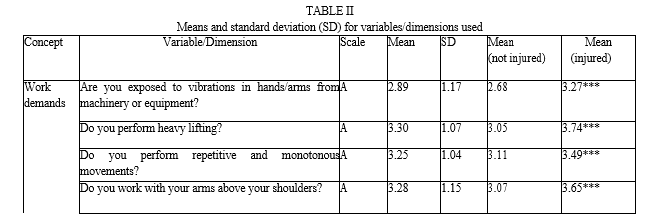

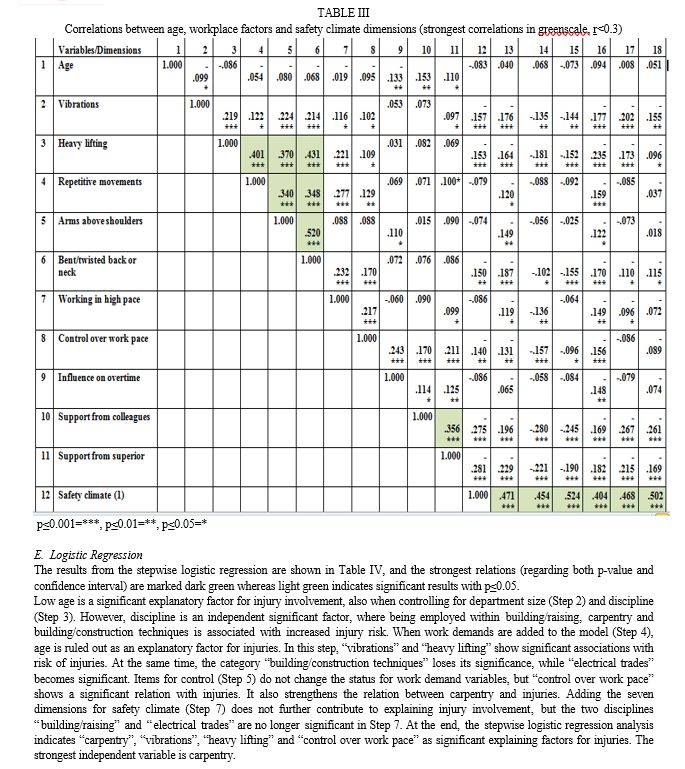
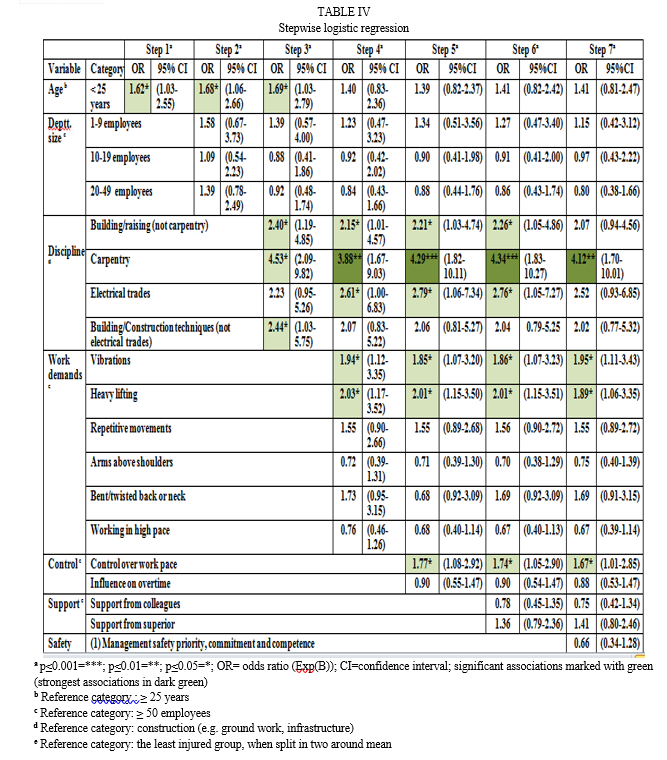

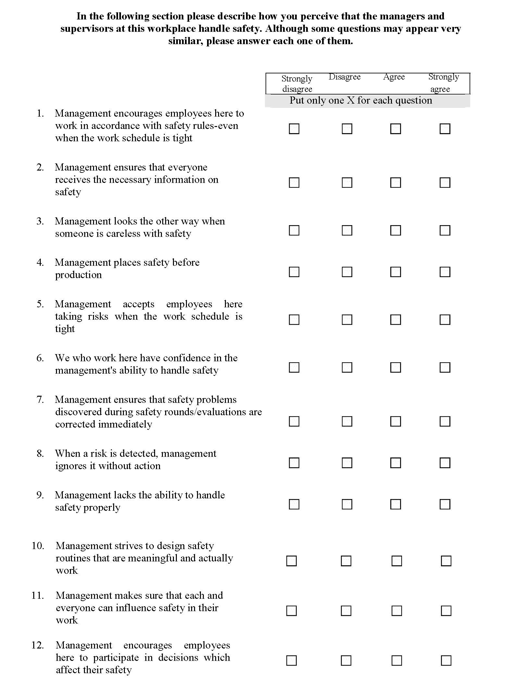

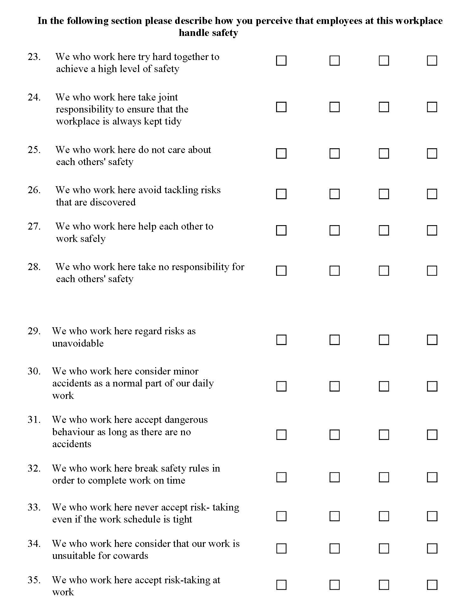
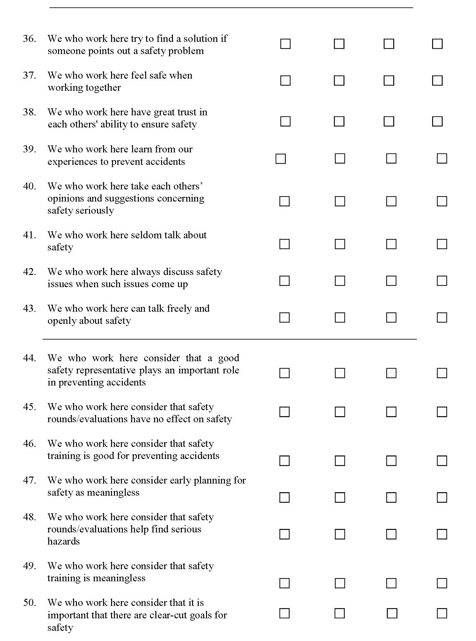

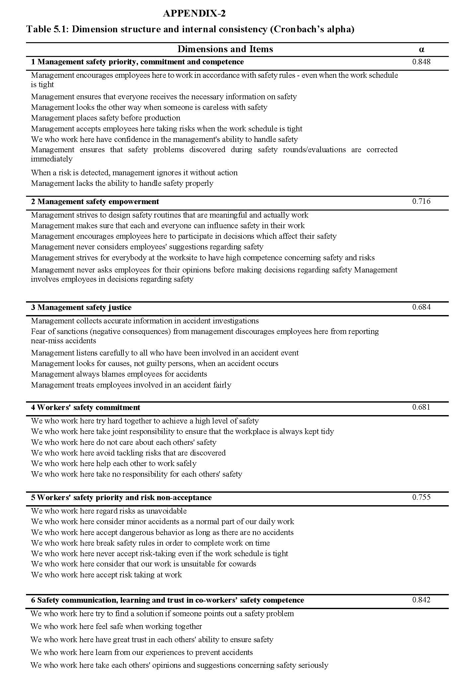
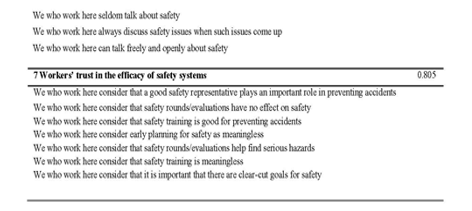
V. DISCUSSION
It has long been known from both local and international studies that construction work is associated with a high accident risk (QCS, 2014), involving all categories of employees, both young and old. Differences have been seen between the injury and illness patterns of younger workers (< 25 years old) compared to older workers. The two main findings of this study are; (1) that young workers have an increased risk for injury involvement, as well as a somewhat different picture of injury types compared to older workers, and (2) that physical and psychosocial factors moderate the association between age and injuries, especially physical work demands (vibration and heavy lifting) and control over work pace. Safety climate has not altered the effect of age, neither did the background variables (department size and discipline).
Discipline has shown an independent association with injuries, with carpentry having the strongest association. Safety climate has changed the importance of discipline, where only carpentry has shown a significant increased risk for injury involvement in the full model (all 7 steps).
The results show young age as an important factor for workplace injury involvement. This is in correspondence with other research findings such as conducted by Salminen (2004), and Breslin et al., (2003). Earlier results saying that young workers have less severe injuries (Breslin et al., 2003) are partially confirmed, taking into consideration that in this study, sample represents a low number of injuries, and that no deaths are included in the material. According to the self-reported injuries presented in this study, it seems that injury rates are declining at the age of 25.
The regression analysis has shown that both physical and psychosocial work factors are associated with injury involvement. Physical demands are known as risk factors for injuries in the construction industry (Ringen et al., 1995). The findings in this study are, therefore, not surprising. Work demands did however reduce the association between young age and injury involvement. The t-tests have shown a higher exposure to physical work demands among young workers; namely vibrations, heavy lifting, repetitive movements and working with arms above shoulders, where vibration and heavy lifting turned out to be significant also in the regression analysis. This is in accordance with the research findings in Breslin et al. (2007b), showing that physical demands have been a risk factor for young workers, and stating that this could be related to the distribution of work tasks between age groups. This result may also reflect the distribution of work tasks between age groups in this study. As the young workers are allocated to the physical work tasks, it is indicative that young workers also become more exposed to hazards and work tasks which may increase the accident risk.
Another factor shown to affect injury involvement is control over work pace, where high control gave reduced risk of workplace injury. Job control has been found to associate with injuries in other studies (Abbe et al., 2011). Those reporting a high degree of control over work pace may have a higher opportunity to prioritize safety in their work, which in the end can reduce risk for injuries. The perceived control may also be related to experience and responsibility, i.e age. More experience can give a better overview over the performance, as well as better skills and abilities to perform work tasks faster.
Safety climate has not shown any association with injury risk in the regression analysis, nor has it altered the association between age and injury risk. No age differences were found on dimension level, which can explain why safety climate assessments did not alter the association between age and injuries. However, some differences have been found between age groups on single item level in the t-tests. It may also be of relevance that the split in age groups in the regression analysis was at age 25.
The analysis of single items showed that young workers assess a higher level of risk-acceptance at work, which can be an expression for their own high safety attitudes and critical opinion on colleagues’ work practice, or their lack of experience and hence higher risk perception. After some years of work, this critical perception may decline, as they become more integrated in the joint culture and ways of working. This assumption can explain why older workers are more critical towards early safety planning and the management’s handling of safety problems, as they emphasize their experience of the company’s actual safety handling more than the apprehension on how it ideally should be. The decreased critical assessments of risk acceptance associated with higher age may, on the other hand, (or at the same time) also indicate that more experience reduces their risk perception related to their workplace. The regression analysis contains 18 independent variables. The sum of missing cases constitutes a challenge, which could had been of less importance if the sample had been larger.
When it comes to the reporting of injuries, it may be differences between age groups in the severity of reported injuries. It may be anticipated that older workers tend to report less of the small injuries (cuts/scratches) compared to younger workers, simply because the injuries are considered frequent and part of the work. Additionally, it can be assumed as less recall bias associated with a six months report period for young workers than for experienced workers, which may affect the amount of reported injuries in the different age groups. This may further affect the results and may lead to an overestimation of age as a risk factor for workplace injuries.
VI. ACKNOWLEDGEMENT
I extend my humble thanks to my parents, wife and children Osaid, Labeeb and Muntasib who have always been inspiring me to carry out research with determination and dedication. My sincere thanks to my brother late Mr. Mushir Ahmad who died because of cancer in 2021 always supported me morally and timely guidance.
Last, but not the least, I thank God, for giving me the strength during the course of this research work.
Conclusion
This paper has evaluated the accident with regards to the young and old workers in a construction industry. A questionnaire survey and structured interviews have been conducted, and it has been found that young workers are at a higher risk for involvement in workplace injuries compared to older workers. However, when adding variables for physical and psychosocial work environment in the safety climate model, the age appears to be of less importance. Physical demands and control over work speed are related with increased risk of injuries. This further shows that the distribution of workloads between different age groups has an impact on injury risk. Safety climate is not associated with risk for injuries. This study also indicates that the work task distributions between age groups should be further explored in relation with risk of injury. Despite the effort made by the majority of construction companies to fulfil their legal, moral and social obligations, difficulties are often encountered in human behaviour which require time and tolerance before acceptable safety standards are achieved. It is essential that careful consideration is given to pre-planning, communication, training, supervision and the dissemination of information, if safe systems and places of work are to be developed and maintained. In accordance with Qatar Labor Law 14 Article (86), a person less than sixteen years of age may not be employed in a workplace of whatsoever nature and shall not be permitted to enter into any place of work such as a construction site (QCS, 2014). Before employing a young person, the company must assess the risks to the young person’s health and safety arising from the work they are required to do, in accordance with these regulations. This assessment must take account of a number of factors, such as: 1) the immaturity and inexperience of young persons, and their lack of awareness of risks 2) the type of work equipment involved and the way of its use 3) the potentiality of hazards to physical, biological and chemical agents 4) any health and safety training that is required for young persons 5) Having carried out this assessment, companies must then determine whether the level of risk has been reduced to as low as is reasonably practicable. There is particular importance placed on avoiding work that: 6) is beyond the young person’s psychological and physical capacity 7) includes exposure to toxic agents which cause genetic disorders or harm to the unborn child or could chemically harm human health 8) includes exposure to radiation, that is harmful 9) includes accident risk unrecognized by young people due their lack of experience and insufficient attention towards safety 10) involves exposure to physical agents such as extreme heat, noise and vibration. Therefore, employers should train all workers and supervisors for an effective heat stress management and control of physical agents in line with QCS 2014 requirements and industries’ best practices (QCS, 2014). The new joiners at the construction site- those who are inexperienced in their field-are similar to the young workers, facing similar problems. They are subjected to a new environment, rules, methods and procedures; under different supervision; working with new colleagues using a variety of tools, equipment and manual effort to produce the work required. Traditionally, it has been seen that health and safety performance has improved because of the improvements in engineering technology and the enhancement in safety management systems. Obviously, this methodology of management and control has reached to its maximum performance and the related improvements in health and safety performance have begun to level off. Future performance gains will only be achieved by taking more account of the way people interact in every aspect of the workplace; and through integrating and understanding the human elements of risk. The comprehensive assessment of the company’s safety climate or culture has a number of valuable benefits. First, it offers the company an understanding of the two types of insight of old and young workers’ orientations, namely, attitudes and behaviours related to safety. Second, the survey results offer a profile of what were believed to be a range of key variables affecting safety culture across the organization and permitted an examination of testable differences between a range of demographic groupings, e.g. by trade or by department. The qualitative evidence provided detailed information about aspects of shared concerns and their impact on workers’ attitudes and behaviour. Taken collectively, the qualitative and quantitative insights allow the development of specific changes to address safety culture in the organization, in essence a contribution to organizational learning. Moreover, a comprehensive approach to the discovered issues may potentially improve the safety culture of the company and, assuming a linkage between safety climate and injury rate, reduce the number of injuries and accidents. The results offer a guide for the development of a short-term and a long-term improvement plan that in the long run could help to drive the safety culture of the company in a more positive direction. Therefore, further studies are required to ensure the complete cataloging of occupational accidents in construction industry in the local context is conducted for measurement of all other factors, not addressed in this study, in comparison with young and old workers.
References
[1] Abbe, O.O., Harvey, C.M., Ikuma, L.H., and Aghazadeh, F. (2011).Modeling the relationship between occupational stressors, psychosocial/physical symptoms and injuries in the construction industry. International Journal of Industrial Ergonomics 41: 106-117. [2] Barker, M., Power, C., and Roberts, I. (1996): Injuries and the risk of disability in teenagers and young adults. Archives of Disease in Childhood; 75: 156–158. [3] Bowling, M.J., Runyan, C., Miara, C., Davis, L., Rubenstein, H., Delp, L., and Gonzalez-Arroyo, M. (1998). Teen workers’ occupational safety: Results of a four school study. Poster at the 4th World Conference on Injury Prevention and Control, Amsterdam, the Netherlands, May 17-20, 1998. [4] Breslin, C., Koehoorn, M., Smith, P., and Manno, M. (2003). Age related differences in work injuries and permanent impairment: a comparison of workers\' compensation claims among adolescents, young adults and adults. Occupational and Environmental Medicine, 60:10, 1-6 [5] Breslin, F. C., Day, D., Tompa, E., Irvin, E., Bhattacharyya, S., Clarke, J., and Wang, A., (2005). Systematic review of risk factors for work injury among youth, Toronto: Institute for Work and Health. [6] Breslin, C. F., Tompa, E., Zhao, R., et al. (2007a): Work disability absence among young workers with respect to earnings losses in the following year. Scandinavian Journal of Work Environment and Health; 33: 192–197. [7] Breslin, C. F., Pole, J. D., Tompa, E., Amick, III, B. C., Smith, P., and Johnson, S. H. (2007b): Antecedents of work disability absence among young people: a prospective study. Annals of Epidemiology; 17: 814–820. [8] Castillo, D.N., Davis, L., and Wegman, D.H. (1999). Young workers. Occupational Medicine. 14(3):519-36.8. [9] Chaffin, D.B. and Ashton-Miller, J.A. (1991). Biomechanical aspects of low-back pain in the older worker. Experimental Aging Research 17 (3). 177–187. [10] Chi, C. F., and Wu, M.L. (1997). Fatal occupational injuries in Taiwan relationship between fatality rate and age. Safety Science, 27(1), 1 –17. [11] Clarke, S. (2000). Safety culture: underspecified and overrated? International Journal of Management Reviews, 2(1), 65-91. [12] Cloutier, E., and Champoux, D. (2000). Injury risk profile and aging among Que´bec firefighters. International Journal of Industrial Ergonomics, 25, 513–523. [13] Cooper, M. D. (2000). Towards a model of safety culture. Safety Science, 36(2), 111-136. [14] Council Directive (1994). Council Directive 94/33/EC of 22 June 1994 on the protection of young people at work, Article 7. [15] Davezies, P. (1992). “The evolution of human functional status according to the age and its consequences on working activities”. Proceedings of the symposium europe\'en of 12 June 1991, europe\'enne Foundation ame\'lioration of Living and Working Conditions, edited by S. Law and F. Gue\'rin Collection Points repe`re, 25-29. [16] De Vos, A.S., Strydom, H., Fouche, C.B. and Delpot, C.S.L. (2002). ‘Research at grass roots: for the social and human service professions’, 2nd Ed. Pretoria: Van Schaik. [17] Engkvist, I.L., Hagberg, M., Linden, A. and Maker, B. (1992). Overexertion back accident among nurses’ aides in Sweden. Safety Science 15, 97–108. [18] EU-OSHA (2015). The European Agency for Safety and Health at Work, Accident Prevention: General questions— Are young workers particularly at risk of accidents at work? Accessed on 12-04-2015 from https://osha.europa.eu/en/faq/accident-prevention/are-young-workers-particularly-at-risk-of-accidents-at-work. [19] Fellows, R and Liu, A. (2008). Research methods for construction, United Kingdom, Blackwell publishing. [20] FLSA (2011). The Fair Labor Standards Act Of 1938 (as amended). U.S. Department of Labor Wage and Hour Division. WH Publication 1318 Revised May 2011. [21] Godwin, A., Eger, T., Salmoni, A., Grenier, S., and Dunn, P. (2007). Postural implications of obtaining line-of-sight for seated operators of underground mining load–haul–dump vehicles, Taylor & Francis group, Vol. 50, No. 2, 192–207. [22] Green, J. and Thorogood, N. (2004). ‘Qualitative methods for health research’, New Delhi, SAGE Publications. [23] Hale, A., and Hovden, J., (1998). Management and culture: the third age of safety. A review of approaches to organisational aspects of safety, health and environment. In: Feyer, A., Williamson, A. (Eds.), Occupational Injury: Risk Prevention and Intervention. Taylor & Francis, London, pp. 129-165. [24] Hargreaves, D. J., and Davies, G. M. (1996): The development of risk-taking in children. Current Psychology; 15: 14–29. [25] Heinrich, H. W., Peterson, D., and Roos, N. (1980) Industrial Accident Prevention. New York: McGraw-Hill. [26] Henning, E., Van Rensburg, W., and Smith (2004). ‘Finding your way in quantitative research’, Pretoria, Van Schaik. [27] Irish Statute Book (1996). Protection of Young Persons (Employment) Act, 1996. Accessed on 17-04-2015 from http://www.irishstatutebook.ie/1996/en/act/pub/0016/index.html [28] Karjalainen, A. (2006). European Agency for Safety and Health at Work. A statistical portrait of the health and safety at work of young workers, Magazine 9, pp. 6–7. [29] Kines P., Lappalainen J., Mikkelsen K.L., Pousette A., Tharaldsen J., Tómasson K., and Törner M., (2011). Nordic Safety Climate Questionnaire (NOSACQ-50): a new tool for measuring occupational safety climate, International Journal of Industrial Ergonomics, 41, 634-646. [30] King, H.F. (1955). An age-analysis of some agricultural accidents. Occupational Psychology 29, 245–253. [31] Kothari, C. R. (2004). ‘Research methodology: Methods and techniques’ 2nd revised Ed, New Delhi, New Age. [32] Kumar, K. (1999). ‘Research Methodology: A step-by-step guide for beginners’, 1st Ed., London, SAGE Publications. [33] Laflamme, L. and Menckel, E. (1995) Aging and occupational accidents: A review of the literature of the last three decades. Safety Science 21, 145-161. [34] Lawton, R., and Parker, D., (1998). Individual divergences in accident liability: a review and integrative approach. Human Factors 40, 655-671. [35] Lindström, K., Dallner, M., Elo, A-L., Gamberale, F., Hottinen, V. Knardahl, S., Skogstad, A. and Ørhede, E (2000). User’s Guide for the QPSNordic. General Nordic Questionnaire for psychological and social factors at work. Nordic Council of Ministers, Nord 2000:12. Copenhagen. [36] Mandel, J.H. and Lohman, W. (1987). Low back pain in nurses: the relative importance of medical history, work factors, exercise, and demographics. Research in Nursing and Health 10, 165–170. [37] Marczyk, G., DeMatteo, D. and Festinger, D. (2005). Essentials of research design and methodology, New Jersey, John Wiley & Sons Inc. [38] Mitchell, O.S. (1988). The relation of age to workplace injuries. Monthly Labor Review 111, 8-13. [39] Neuman, W.L. (2000). ‘Social research methods: qualitative and quantitative approaches’, 2nd Ed., South Africa, Oxford University Press. [40] Nielsen, K. J., Rasmussen, K., Glasscock, D. J., and Spangenberg, S. (2008). Changes in safety climate and accidents at two identical manufacturing plants. Safety Science, 46(3), 440-449. [41] NIOSH (2003). NIOSH alert: Preventing deaths, injuries, and illnesses of 3 young workers. Cincinnati, OH: U.S. Department of Health and Human Services, Public Health Service, Centers for Disease Control and Prevention, NIOSH Publication No. 2003-128. [42] Oliver, P. (2004). Writing your thesis. London: SAGE Publications Ltd. [43] Probst, T. M., and Brubaker, T. L. (2001). The effects of job insecurity on employee safety outcomes: Cross-sectional and longitudinal explorations. Journal of Occupational Health Psychology, 6(2), 139-159. [44] QCS (2014). Qatar Construction Specifications 2014, Section 11, Ministry of Environment, State of Qatar. [45] Rantanen, J. (2003). How to ensure decent work for the young people in the 21st century? In: Rantanen, J. et al., FIOH. Proceedings of the International Symposium on Youth and Work, pp. 2–9. [46] Rasmussen, K., Hansen, K., Nielsen, K. and Andersen, D. R. (2011): Incidence of work injuries amongst Danish adolescents and their association with work environment factors. American Journal of Industrial Medicine; 54: 143–152. [47] Rhodes, S.R. (1983). Age-related differences in work attitudes and behaviour: a review and conceptual analysis. Psychological Bulletin 93, 328–367. [48] Ringen, K., Seegal J., and Englund A. (1995). Safety and health in the construction industry. Annual review of public health. 16: 165-188. [49] Root, N., and Hoefer, M. (1979). \"The first work injury data available from new BLS study,\" Monthly Labor Review, Bureau of Labour Statistics, pp. 76-80. [50] Root, N. (1981). Injuries at work are fewer among older employees. Monthly Labor Review, The Office of Occupational Safety and Health Statistics, Bureau of Labour Statistics;104: 30-4. [51] Runyan, C.W., and Zakocs, R. (2000). Epidemiology and prevention of injuries among adolescent workers in the United States. Annu 7. Rev Public Health. 21:247-269. [52] Salminen, S. (2004). ‘Have young workers more injuries than older ones? An international literature review’. Journal of Safety Research, 35, pp. 513–521. [53] Schmidt. J.K., Petree. B.L., Daniel, J.P., Olive, K. and Lamont, N.B. (1984). The effect of age cohort, job family, and task variability on industrial accident rates. Proceedings of the Human Factors Society - 28th Annual Meeting, pp. 745-750. [54] Shannon, H.S., and Lowe, G.S. (2002). How many injured workers do not file claims for workers’ compensation benefits? American Journal of Industrial Medicine. 42(6):467-73. [55] Siskind, F. (1982). Another look at the link between work injuries and job experience. Monthly Labor Review, 105, 38– 40. [56] Stubbs, D. A. and Nicholson, A. S., (1979). “Manual Handling and Back Injuries in the Construction Industry: An Investigation,” Journal of Occupational Accidents, Vol. 2, No. 3, pp. 179-90. [57] Thompson, R. C., Hilton, T. F., and Wilt, L. A. (1998). Where the safety rubber meets the shop floor: A confirmatory model of management influence on workplace safety. Journal of Safety Research, 29(1),15-24. [58] Van Zelst, R.H., (1954). The effects of age and experience upon accident rate. J. Appl. Psychol.. 38 (5): 313-317. [59] Vernon, H.M. and Bedford, T., (1928). A study of absenteeism in a group of ten collieries. Industrial Fatigue Research Board, pp. 15-30. [60] Wallace, J. C., Popp, E., and Mondore, S. (2006). Safety Climate as a Mediator Between Foundation Climates and Occupational Accidents: A group-Level Investigation. Journal of Applied Psychology, 91(3), 681-689. [61] Warr, P. (1994). Age and employment. In Handbook of Industrial and Organizational Psychology, eds. H.C. Triandis. M.D. Dunnette and L.M. Hough, 2nd edn, Vol 4, pp. 485-550. Consulting Psychologists Press, Palo Alto. [62] Wegman, D.H. and McGee, J.P. (2004). National Research Council and the Institute of Medicine. Health and Safety Needs of Older Workers. Committee on the Health and Safety Needs of Older Workers. Division of Behavioral and Social Sciences and Education. Washington, DC: The National Academies Press. [63] Welman, C., Kruger, F. and Mitchel, B. (2006). Research methodology, 3rd Ed. South Africa, Oxford University Press. [64] Welman, C. and Kruger, F. (2003). ‘Research methodology for the business and administrative sciences’, 2nd Ed, South Africa, Oxford University Press. [65] WHO (2002). World Health Organization, Active aging: a policy framework, Geneva, Switzerland. [66] WHO (2005). Occupational Health. Number of work-related accidents and illnesses continues to increase: WHO and ILO join in call for prevention strategies. Accessed on 18-02-2015 from http://www.who.int/occupational_health/mediacentre/pr280405/en/ [67] Zohar, D. (2000). A Group-Level Model of Safety Climate: Testing the Effect of Group Climate on Microaccidents in Manufacturing Jobs. Journal of Applied Psychology, 85(4), 587-596.
Copyright
Copyright © 2024 Ahmad Aseer. This is an open access article distributed under the Creative Commons Attribution License, which permits unrestricted use, distribution, and reproduction in any medium, provided the original work is properly cited.

Download Paper
Paper Id : IJRASET58309
Publish Date : 2024-02-05
ISSN : 2321-9653
Publisher Name : IJRASET
DOI Link : Click Here
 Submit Paper Online
Submit Paper Online

